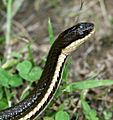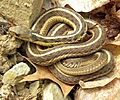List of snakes of Indiana facts for kids
Indiana is home to many amazing creatures, and that includes 39 different types of snakes! These snakes live in all sorts of places across the state, from forests to wetlands. Some are quite common, while others are very rare and need our help to survive. It's important to learn about these slithery neighbors, understand where they live, and know which ones are safe to be around and which ones you should admire from a distance.
Contents
Meet Indiana's Snakes
Indiana has a wide variety of snakes, each with its own unique look and habits. They play an important role in the environment, helping to keep insect and rodent populations in check. While some snakes can be a bit scary to think about, most of Indiana's snakes are harmless to humans.
Venomous Snakes to Know
Out of the 39 types of snakes in Indiana, only a few are venomous. This means they can inject venom if they bite, which can be dangerous to humans. It's super important to know these snakes so you can stay safe by giving them plenty of space.
Copperhead
The Northern Copperhead is found in the southern half of Indiana. It has a unique pattern that helps it blend in with leaves on the forest floor. If you see one, it's best to keep your distance. Its bite is considered a moderate threat to humans.
Cottonmouth
The Western Cottonmouth is a very rare snake in Indiana, found only in Dubois and Harrison counties. It's also known as a "water moccasin" because it lives near water. This snake is state endangered, meaning it's very close to disappearing from Indiana. Its bite is a high threat, so it's crucial to never approach it.
Timber Rattlesnake
The Timber Rattlesnake lives in the southern third of Indiana. It's known for the rattle on its tail, which it shakes as a warning. This snake is also state endangered. Its bite is considered a very high threat, so if you hear a rattle, back away slowly and carefully.
Eastern Massasauga Rattlesnake
Another rattlesnake, the Eastern Massasauga Rattlesnake, lives in the northern third of Indiana. Like the Timber Rattlesnake, it has a rattle and is state endangered. It's also a "federal candidate," meaning it's being considered for federal protection. Its bite is a high threat, so always be cautious in areas where it might live.
Non-Venomous Snakes
Most of the snakes you might see in Indiana are not venomous. These snakes are generally harmless to humans, though they might bite if they feel threatened, just like any wild animal. Their bites are usually not serious and feel more like a scratch.
Racers
Indiana has two types of racers: the Blue Racer and the Southern Black Racer. Blue Racers are common in the northern two-thirds of the state, while Black Racers are found in the southern third. They are fast-moving snakes that help control pests. They pose a minimal threat to humans.
Kingsnakes
Kingsnakes are known for being able to eat other snakes, even venomous ones! The Prairie Kingsnake is found in the southwest, south-central, and western border areas. The Black Kingsnake is common in the southwestern third. The Red Milk Snake and Eastern Milk Snake are also found across the state. All kingsnakes are a minimal threat to humans.
Water Snakes
Several types of water snakes live in Indiana, often near ponds, lakes, and rivers. The Northern Diamondback Water Snake is abundant in the southwestern corner. The Midland Water Snake and Northern Water Snake are common throughout much of the state. These snakes are not venomous and pose a minimal threat to humans. However, the Copperbelly Water Snake is special; it's state endangered and federally threatened, found in the southern third and northeast corner.
Garter Snakes
Garter snakes are some of the most commonly seen snakes. The Eastern Garter Snake is abundant throughout Indiana. Other types include the Butler's Garter Snake (state endangered in the northeast), the Western Ribbon Snake, the Plains Garter Snake, the Eastern Ribbon Snake, and the Northern Ribbon Snake. They all pose a minimal threat to humans.
Other Interesting Snakes
- The Midwestern Worm Snake is a small snake found in the southern half of Indiana. It's harmless.
- The Eastern Hognose Snake is known for playing dead when threatened! It's found throughout the state and is not dangerous.
- The Northern Rough Green Snake and Western Smooth Green Snake are beautiful green snakes. The Western Smooth Green Snake is state endangered in the northwest. They are harmless.
- The Black Rat Snake is common throughout Indiana and is a great climber. The Western Fox Snake and Gray Rat Snake are also found in parts of the state. None of these are dangerous.
- The Bullsnake is a large snake found in the northwest. It can hiss loudly but is not venomous.
- The Queen Snake lives near water and eats crayfish. It's found almost everywhere but the southwestern corner and is harmless.
- The Northern Brown Snake and Midland Brown Snake are small, abundant snakes found throughout the state.
- The Northern Redbelly Snake is another small, harmless snake.
- The Western Earth Snake is a small, uncommon snake in the southwestern third.
Snakes Needing Our Help
Many of Indiana's snakes are doing well, but some are facing challenges and need protection. When a snake is listed as state endangered, it means there are very few left in Indiana, and they are at risk of disappearing completely. Some are even federally threatened, meaning they are protected by the U.S. government.
Snakes like the Western Cottonmouth, Northern Scarlet Snake, Kirtland's Snake, Timber Rattlesnake, Western Mud Snake (which is possibly gone from Indiana, or "extirpated"), Copperbelly Water Snake, Western Smooth Green Snake, Eastern Massasauga Rattlesnake, Southeastern Crowned Snake, and Butler's Garter Snake are all in danger. Protecting their habitats and learning about them helps these amazing creatures survive.
Images for kids
-
.
Western Cottonmouth

































